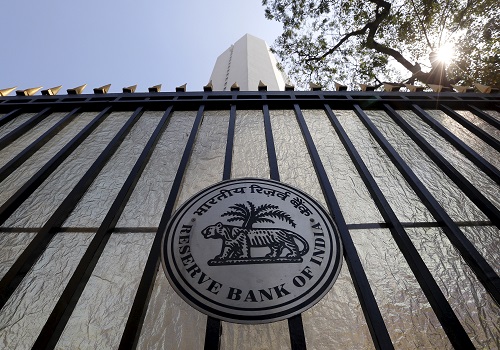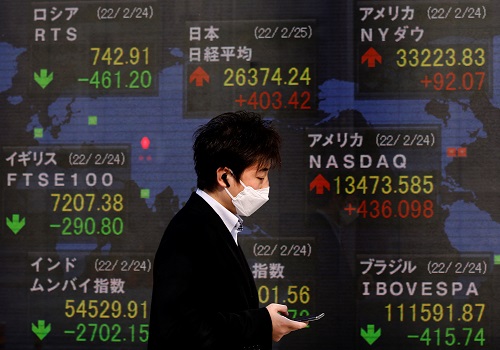Gold trading range for the day is 61970-63730 - Kedia Advisory

Follow us Now on Telegram ! Get daily 10 - 12 important updates on Business, Finance and Investment. Join our Telegram Channel
Gold:
Gold recorded a gain of 0.37% yesterday, settling at 62965, propelled by concerns over the U.S. labor market's apparent loss of momentum, highlighted by a surge in first-time unemployment benefit applications. The Federal Reserve's decision to keep interest rates unchanged was accompanied by Chair Jerome Powell's assertion during the press conference that rate cuts in March are unlikely, pushing back against market expectations. India's gold demand is anticipated to be subdued in the first quarter of 2024 due to lower jewelry sales, as stated by the World Gold Council (WGC). However, annual demand is expected to rise, potentially supporting prices near record highs. The WGC predicts a breakout from the 700-800 metric ton range of gold demand in India over the past five years, reaching between 800 and 900 tons in 2024. This could impact India's trade deficit and put pressure on the rupee. Globally, gold demand trading decreased by 5% to 4,448.4 metric tons in 2023, yet remained robust compared to the 10-year average due to ongoing geopolitical and economic uncertainties, according to the WGC. Technically, the market is witnessing fresh buying, with a 1.98% increase in open interest, settling at 15674. Gold finds support at 62470, and a breach below could test 61970 levels. Resistance is anticipated at 63350, and a move above might lead to testing 63730.
Trading Ideas:
* Gold trading range for the day is 61970-63730.
* Gold gains as the U.S. labor market appears to be losing momentum
* India's gold demand to rise in 2024 despite subdued March quarter – WGC
* Indian gold demand fell 3% in 2023 from the prior year to 747.5 tons, the lowest since 2020
Silver:
Silver closed marginally lower by -0.04%, settling at 72218, as economic uncertainties and cautious sentiment surrounding interest rates restrained investor demand. Federal Reserve Chair Jerome Powell indicated that the central bank is unlikely to cut rates in March, citing concerns about having sufficient confidence in inflation data. The U.S. labor market's apparent loss of momentum, with an increase in first-time unemployment benefit applications to 224,000, added to the cautious outlook. Globally, the silver market is expected to experience a 9% reduction in the deficit to 176 million troy ounces in 2024. A projected 4% recovery in mine output is anticipated to counterbalance the rising demand for silver. Despite facing a fourth consecutive year of a structural market deficit, the Silver Institute predicts a 1% increase in global demand to 1.2 billion ounces in 2024, mainly due to stronger industrial consumption. On the supply side, global silver supply is forecasted to grow by 3% to reach an eight-year high of 1.02 billion ounces in 2024. This growth is led by a 4% increase in mine production, even though silver recycling is expected to decline by 3%. From a technical perspective, the silver market is currently under fresh selling pressure, with a 3.19% increase in open interest to 23873, coupled with a price decline of -29 rupees. Support for silver is identified at 71335, and a breach below could lead to a test of 70450 levels. On the upside, resistance is likely at 72770, and a move above could result in prices testing 73320.
Trading Ideas:
* Silver trading range for the day is 70450-73320.
* Silver steadied as investors reduced their expectations of early interest rate cuts this year
* The global silver deficit is expected to ease by 9% to 176 million troy ounces in 2024
* U.S. consumer confidence increased to a two-year high in January
Crude oil:
Crude oil prices recorded a decline of -1.69% yesterday, settling at 6206, as traders monitored efforts to broker a cease-fire in the Israel-Hamas conflict. Global oil demand is expected to rise by 2 million barrels per day in 2024, surpassing the previous forecast of 1.24 million bpd, according to the International Energy Agency (IEA) Executive Director Fatih Birol. Prospects of interest rate cuts in major economies and stimulus measures in China have contributed to an optimistic demand outlook. On the supply side, concerns persist due to Houthi attacks on Red Sea shipping and the potential for a direct confrontation between the U.S. and Iran, adding a risk premium to oil prices. OPEC+ will review the extension of voluntary oil production cuts of 2.2 million barrels per day in early March. Russian Deputy Prime Minister Alexander Novak affirmed OPEC+'s readiness to act at any moment to support the oil market, considering Middle East tensions and other risks. In November, U.S. crude oil shipments via rail declined by 25,000 bpd from the previous month to 241,000 bpd. Technically, the market is undergoing fresh selling with a 2.34% increase in open interest, settling at 8801. Crude oil finds support at 6117, and a breach below could test 6027 levels. Resistance is anticipated at 6342, with a move above potentially leading to prices testing 6477. Traders are closely monitoring geopolitical developments, OPEC+ decisions, and global economic conditions for further insights into crude oil market dynamics.
Trading Ideas:
* Crudeoil trading range for the day is 6027-6477.
* Crudeoil dropped on attempts to a cease-fire in the Israel-Hamas conflict.
* IEA executive director Fatih Birol recently stated that global oil demand will likely increase by 2 mbpd in 2024.
* OPEC+ in early March will review whether to extend 2.2 million barrels per day of voluntary oil production cuts
Natural gas:
Natural gas faced a decline of -3.33%, settling at 171.3, driven by forecasts indicating warmer-than-normal weather persisting through mid-February. The prolonged warmer conditions are expected to keep heating demand low, despite bullish drops in output this week and forecasts for increased demand next week. The ongoing outage of a liquefaction train at Freeport LNG's export plant in Texas also contributed to the bearish sentiment. Financial firm LSEG reported a notable decrease in gas output in the U.S. Lower 48 states, averaging 103.8 billion cubic feet per day (bcfd) in January, down from the monthly record high of 108.0 bcfd in December. Despite a bullish drop in output earlier this week and forecasts for increased demand, the lack of significant price movement suggests the market's sensitivity to the warmer weather outlook. Meteorologists project warmer-than-normal temperatures in the Lower 48 states until at least Feb. 16, with a slightly cooler outlook for the following week. LSEG forecasts a rise in U.S. gas demand, including exports, from 126.7 bcfd this week to 127.5 bcfd next week, despite the earlier outlook on Wednesday being lower. From a technical perspective, the natural gas market is undergoing fresh selling, evident in the 9.38% increase in open interest to 68942, alongside a price decrease of -5.9 rupees. Support for natural gas is identified at 167.7, with a potential test of 164 levels below. On the upside, resistance is likely at 177.9, and a move above could result in prices testing 184.4.
Trading Ideas:
* Naturalgas trading range for the day is 164-184.4
* Natural gas prices dropped due to forecasts of warmer than normal weather.
* Global natural gas demand is set to rise by 2.5% in 2024 versus 2023
* IEA expects China’s liquefied natural gas imports to grow by more than 10% from 2023 levels
Copper:
Copper prices experienced a decline of -0.89% yesterday, settling at 726.75, influenced by a stronger dollar and indications of no U.S. rate cut in March. However, positive data from China and tightening supply dynamics provided some support. The Caixin China General Manufacturing PMI for January unexpectedly held at 50.8, surpassing market forecasts and marking the third consecutive month of growth in factory activity, contrary to official data indicating pre-Lunar New Year weakness. Notably, stocks in LME-registered warehouses have decreased by 24% since October, reaching their lowest point since September at 146,475 tons. Despite this, the significant discount for cash over three-month copper contracts suggests the market remains unconcerned about supply shortages on the LME market. The China Nonferrous Metals Industry Association (CNIA) recommended copper smelters cut production and delay new projects due to tightening raw material supplies. China, the world's top copper consumer, has faced unexpected challenges with copper concentrate supplies after the closure of a major copper mine in Panama, coinciding with smelters' expansion plans. Top copper smelters have proposed production cuts, though no specific plan has been agreed upon. In 2023, China's refined copper output reached a record high of 12.99 million metric tons, reflecting a 13.5% increase from 2022, according to data from the National Bureau of Statistics. Technically, the market is undergoing fresh selling, with a 1.36% increase in open interest, settling at 4636. Copper finds support at 724.6, and a breach below could test 722.4 levels. Resistance is anticipated at 730.5, with a move above potentially leading to prices testing 734.2.
Trading Ideas:
* Copper trading range for the day is 722.4-734.2.
* Copper prices fell due to a stronger dollar and signals of no U.S. rate cut in March.
* Chinese copper smelters propose output cuts on concentrate tightness
* CNIA said it had advised copper smelters to cut production and postpone new projects amid tightening raw material supplies.
Zinc:
Zinc witnessed a decline of -1.91%, settling at 220.9, as concerns over China's economic activity persisted. China's official PMI data revealed the fourth consecutive month of contraction in factory activity, contributing to investor disappointment and uncertainty about a turning point in China's economic growth. The unexpected contraction comes despite the Caixin China General Manufacturing PMI unexpectedly holding at 50.8 in January, the same as December, beating market forecasts and marking the third straight month of growth in factory activity. Swedish miner Boliden's decision to scale down operations and reduce targeted output at its Tara zinc mine in Ireland further added to the negative sentiment. The mine, Europe's largest zinc mine, was placed on care and maintenance in June due to a three-year low in zinc prices. Boliden is in talks with staff for a planned resumption in the second quarter of this year. In the global zinc market, the deficit expanded to 71,600 metric tons in November 2023 from 62,500 tons in October, according to data from the International Lead and Zinc Study Group (ILZSG). Technically, the zinc market is under fresh selling pressure, marked by a 21.51% increase in open interest to 3536, accompanied by a price decline of -4.3 rupees. Support for zinc is identified at 219.7, with a potential test of 218.4 levels below. On the upside, resistance is likely at 223.1, and a move above could lead to testing 225.2.
Trading Ideas:
* Zinc trading range for the day is 218.4-225.2.
* Zinc dropped as sentiment over China's economic activity continues to be clouded
* Global zinc supplies estimated at around 14 million tons
* Lack of concern about zinc supplies can be seen in the discount for cash over three-month zinc contracts.
Aluminium:
Aluminium prices experienced a decline of -1.17% yesterday, settling at 202.5, influenced by various factors, including China's significant increase in imports of unwrought aluminium in 2023. China's imports more than doubled year-on-year, reaching 1.54 million metric tons, the second-highest annual total since the beginning of the century, falling just short of the record set in 2021. The surge in imports reflects robust demand for primary metal in China. The Caixin China General Manufacturing PMI for January unexpectedly remained at 50.8, signaling the third consecutive month of growth in factory activity. This contrasted with official data, highlighting a strengthening manufacturing sector ahead of the Lunar New Year celebration. In contrast, Japan's imports of primary aluminium fell by 26% to 1.03 million metric tons in 2023, marking the lowest figure since at least 1986. This decline is attributed to slow demand in the construction and manufacturing industries. Japan, being a major importer of aluminium in Asia, sets the benchmark premiums for primary metal shipments over the London Metal Exchange (LME) cash price for the region. Technically, the aluminium market is witnessing fresh selling with a 0.57% increase in open interest, settling at 3887. Aluminium finds support at 201.8, and a breach below could test 201.1 levels. Resistance is anticipated at 203.7, with a move above potentially leading to prices testing 204.9. Traders are closely monitoring import trends, global manufacturing activity, and regional benchmarks for further insights into aluminium market dynamics.
Trading Ideas:
* Aluminium trading range for the day is 201.1-204.9.
* Aluminium dropped on profit booking after prices rose after real estate "white list" and purchasing restrictions ease
* China produced 3.59 million tons of primary aluminium in December, a 4.9% increase from the previous year
* China factory activity shrinks for 4th month: NBS
Cotton candy:
Cotton prices, represented by Cottoncandy, registered a notable gain of 1.44% yesterday, settling at 57840. The upward movement is attributed to a combination of factors, including a reduction in the current season's estimated cotton production, decreased world consumption forecast for 2023/24, and higher projected ending stocks globally. The world consumption estimate for 2023/24 has decreased by 1.3 million bales, with reductions noted for major cotton-consuming countries such as India, Indonesia, Pakistan, Uzbekistan, and Turkey. The higher beginning stocks, increased production (except for the U.S.), and lower consumption have led to a 2.0 million bales rise in world ending stocks for 2023/24. The Cotton Association of India (CAI) maintains a flat estimate for domestic consumption of cotton at 311 lakh bales for the 2023-24 season. CAI's projections for total cotton supply until the end of the cotton season in September 2024 remain at 345 lakh bales. Brazil's cotton production reached a historic high in the 2022-23 season, contributing to a rise in global supply. However, sluggish demand, influenced by unfavorable economic conditions, resulted in bloated inventories and reduced cotton prices worldwide. Despite the global oversupply situation, there are reports of a decline in pink bollworm infestation in the cotton crop in India, reducing from 30.62% in 2017-18 to 10.80% in 2022-23. Technically, the cotton market is experiencing fresh buying, with a 7.8% increase in open interest, settling at 304. Cottoncandy finds support at 57240, with a breach potentially leading to a test of 56630 levels. Resistance is anticipated at 58220, and a move above could see prices testing 58590.
Trading Ideas;
* Cottoncandy trading range for the day is 56630-58590.
* Cotton gains as production is estimated at 317.57 lakh bales against 336.60 lakh bales.
* World 2023/24 ending stocks are forecast 2.0 million bales higher this month driven by higher beginning stocks.
* World production is 260,000 bales higher with China’s crop up 500,000 bales and Argentina’s production higher as well
In Rajkot, a major spot market, the price ended at 26481 Rupees dropped by -0.12 percent.
Turmeric:
Turmeric prices rebounded by 3.35% to settle at 14568, driven by low-level recovery after a previous dip attributed to sluggish buying activities ahead of the anticipated release of stocks coinciding with the onset of new crops. The market experienced pressure due to improved crop conditions resulting from favorable weather, but the downside remained limited, supported by weaker production prospects and tighter stocks. Enhanced export opportunities further contributed to maintaining price stability, as evidenced by a 25% increase in exports, driven by improved demand in both developed and emerging nations. Despite this, the crop condition is reported to be satisfactory, with harvest readiness expected between January and March. The current levels of buying activity, coupled with decreasing supplies, are expected to sustain price stability in the turmeric market. November 2023 saw a 15.34% fall in exports compared to October, and a notable drop of 30.78% compared to November 2022. Technically, the turmeric market is undergoing short covering, with a 2.1% drop in open interest to settle at 12380, while prices surged by 472 rupees. Turmeric is currently supported at 14134, and a breach below this level could test 13700. On the upside, resistance is expected at 14820, with a potential move above leading to a test of 15072. The technical overview suggests a delicate balance in the turmeric market, with factors like production prospects, export trends, and regional dynamics influencing its performance.
Trading Ideas:
* Turmeric trading range for the day is 13700-15072.
* Turmeric gained on low level recovery after prices dropped ahead commencement of new crops.
* Pressure also seen amid expectation of release of stocks ahead of commencement of new crops.
* Prices also dropped amid Improved crop condition due to favorable weather condition.
* In Nizamabad, a major spot market, the price ended at 13675.25 Rupees gained by 0.57 percent.
Jeera:
Jeera prices demonstrated a rebound of 0.68% to settle at 27295, driven by short-covering following a decline influenced by optimistic production prospects in key states like Gujarat and Rajasthan. The current rabi season witnessed a four-year high in jeera acreage, with farmers significantly expanding cultivation in response to record prices observed in the previous marketing season. Gujarat saw a remarkable 160% increase, covering 5.60 lakh hectares compared to the previous year's 2.75 lakh hectares, surpassing the normal acreage of 3.5 lakh hectares. Rajasthan also experienced a 25% surge, reaching 6.90 lakh hectares compared to the previous year's 5.50 lakh hectares. Despite the domestic surge in production, global demand for Indian jeera declined as buyers favored alternative markets like Syria and Turkey due to higher prices in India. Export data from Apr-Nov 2023 indicated a substantial 33.10% drop at 84,467.16 tonnes compared to the same period in 2022. Technically, the jeera market is under short covering, with a 1.94% drop in open interest settling at 1971, while prices rose by 185 rupees. Jeera is currently finding support at 26930, and a dip below this level could lead to a test of 26550. On the upside, resistance is expected at 27620, and a breakthrough could see prices testing 27930. The delicate balance between robust domestic production and weakened global demand influences the jeera market's performance, with market participants closely monitoring factors like export trends, climatic conditions, and acreage data for cues on future price movements.
Trading Ideas:
# Jeera trading range for the day is 26550-27930.
* Jeera gained on short covering after prices dropped due to higher production prospects
* In Gujarat, Cumin sowing witnessed very strong growth by nearly 103% with 530,030.00 hectares against sown area of 2022
* Stockists are showing interest in buying on recent downfall in prices triggering short covering.
* In Unjha, a major spot market, the price ended at 32493.35 Rupees dropped by -0.19 percent.
Views express by all participants are for information & academic purpose only. Kindly read disclaimer before referring below views. Click Here For Disclaimer
.












 320-x-100_uti_gold.jpg" alt="Advertisement">
320-x-100_uti_gold.jpg" alt="Advertisement">









